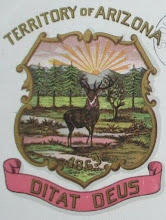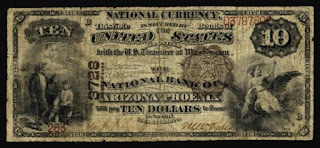Forward
While the internet has been upon us for many years, specific information about currency issued by national banks in Arizona remains almost as scarce as the banknotes themselves. Hopefully, this blog will in a small way change that. Relevant information on the banknotes, as well as other information such as the buildings (then & now), ephemera, signers, and related history will be displayed. While the goal will be accuracy, it is understood that this will not always be the case and feedback\corrections are welcome.
What Are National Banknotes?
National banks were authorized by Congress in 1863. One of the provisions within the enabling legislation provided for currency issuing privileges. Once chartered, a bank could buy certain bonds of the U.S. government, deposit them with the Treasury, and receive up to 90% of that amount in currency printed with the banks name. The bank then circulated the currency locally thru loans and other transactions.
In response to a serious financial downturn resultant from the Panic of 1907, "Other Securities" were as well additionally accepted for backing national banknotes between 1908 and 1916.
The note-issuing privilege was withdrawn (suspended) in 1935, primarily due to the Federal Reserve System (Est. 1913) having assumed primary responsibilty for the issuing of currency.
Charter Periods
First Charter Period : 1863-1882 (Also known as Original Series)
Second Charter Period : 1882 - 1902 (AKA Series of 1882)
Third Charter Period : 1902 - 1922* (Series of 1902)
Fourth Charter (So-Called) Charters initially granted or renewed from late 1921 through June 30th, 1922, when Congress passed an act extending the Third Charter to 99 years. Later, the term would change to "in perpetuity". This term is not official, and many do not understand what actually would constitute a "Fourth Charter" note. In Arizona, it is believed that only #12198, The First National Bank of Holbrook, would qualify.
If a bank was chartered (or rechartered) within one of these charter periods, that was the series of national banknotes they would issue until their charter was renewed. After 1922, all notes were of the 1902 series. When currency designs were standardized in 1929, small-size notes were issued.
List of Issuing Banks from Arizona (Click on links at left)
Over 12,000 national banks nationwide issued curreny at one time or another during the note-issuing period (1863-1935), including the following from Arizona.
I
2639 : The First National Bank of TUCSON (1882-1885)
3054 : The First National Bank of PHOENIX (1883-1884)
3122 : The First National Bank of PRESCOTT (1884-1885)
3728 : The National Bank of Arizona at PHOENIX (1887-1926)
3728 : First National Bank of Arizona at PHOENIX (1926-1935)
4287 : The Consolidated National Bank of TUCSON (1890-1935)
II
4440 : The Arizona National Bank of TUCSON (1890-1928)
4729 : The PHOENIX National Bank (1892-1935)
4851 : The PRESCOTT National Bank (1892-1916)
5720 : The TEMPE National Bank (1901-1935)
III
5821 : The First National Bank of CLIFTON (1901-1923)
6439 : The First National Bank of TOMBSTONE (1902-1926)
6579 : The First National Bank of GLOBE (1903-1924)
6591 : The Sandoval National Bank of NOGALES (1903-1904)
6591 : The First National Bank of NOGALES (1903-1935)
IV
6633 : The First National Bank of DOUGLAS (1903-1935)
7182 : The First National Bank of BISBEE (1904-1908)
7591 : The First National Bank of YUMA (1905-1929)
8193 : The GLOBE National Bank (1906-1910)
9608 : The YUMA National Bank (1909-1929)
10998 : The First National Bank of FLORENCE (1917-1933)
11012 : The NOGALES National Bank (1917-1931)
11020 : The First National Bank of FLAGSTAFF (1918-1931)
11030 : The First National Bank of MESA (1918-1932)
V
11159 : The TUCSON National Bank (1918-1923)
11559 : The Commercial National Bank of PHOENIX (1919-1931)
12198 : The First National Bank of HOLBROOK (1922-1935)
12581 : The First National Bank of WINSLOW (1924-1935)
13262 : First National Bank in PRESCOTT (1928-1932)
Appendices \ References & Acknowledgements
Thursday, January 21, 2010
2639 The First National Bank of TUCSON
1882
January 24th - Organized
March 1st - Chartered #2639
Succeeded the Pima County Bank
1885
January 31st - Voluntarily liquidated with capital of $100,000.
Succeeded by the Bank of Tucson
Post
1887
Bank of Tucson merges with Bank of D. Henderson to form The Consolidated Bank of Tucson. Henderson would later buy out the Jacobs Brothers.
1890
The Consolidated Bank obtains a federal charter, becoming The Consolidated National Bank (#4287)
The bought-out Jacobs Family buys control of The Santa Cruz Valley bank, converting it soon after into the The Arizona National Bank (#4440)
The principals of two Tucson mercantile firms, Tully-Ochoa and The Mark I. Jacobs Company organized the Pima County Bank in 1879. Realizing there could be advantages to obtaining a federal charter, they reorganized into The First National Bank of Tucson in 1882. As an offshoot of the Jacobs family's mercantile business, greenbacks had been bought locally for an average 70 cents on the dollar in gold or silver, then transported to San Francisco to be traded for an average of 88 cents on the dollar. The opportunity led to the family business being shifted into a bullion and exchange company. The sons eventually bought out their father's interest, and along with other stockholders incorporated into The Pima County Bank, on January 1st, 1879. The co-owner of Tully-Ochoa, was brought in as the banks president in 1880, with brothers Lionel and Barron Jacobs as vice president and cashier. The brothers then liquidated their mercantile operations. In early 1882, they decided to nationalize the bank. While initially successful, declining silver prices primarily led the brothers to downsize by early 1885, giving up the national charter in favor of the territorial-chartered Bank of Tucson. Merging two years later with the firm of D. Henderson, Banker, The Consolidated Bank of Tucson was formed. In 1890, Henderson bought out the Jacobs interest, and then applied for a national charter, becoming The Consolidated National Bank. The Jacob's soon after bought control of The Santa Cruz Valley Bank, which they in turn reorganized into The Arizona National Bank of Tucson, Charter # 4440.
Chartered late in the first charter period, the bank issued "First Charter" AKA "Original Series" notes, the only Arizona bank (state or territory) to do so. The bank opted to issue only five dollar notes. Surprisingly, at least four notes have survived. As shown on the photographs, there is no territorial seal. Instead, the eagle on the right is duplicated. The placement of jurisdictional seals was often an inconsistent practice, and Arizona notes never bore the territorial seal.
Territorial Issues (Only)
First Charter, Series 1875
$5-$5-$5-$5 #1 - 2120
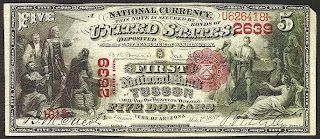 (B)
(B) 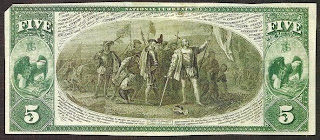
Total Circulation = $42,400
Outstanding at Close = $28,100
Outstanding in 1910 = $335
Total notes issued = 8480
Notes Known as of 2018 = 4
Last Known Sale: $218,500 in June 2008 (Above Note)
January 24th - Organized
March 1st - Chartered #2639
Succeeded the Pima County Bank
1885
January 31st - Voluntarily liquidated with capital of $100,000.
Succeeded by the Bank of Tucson
Post
1887
Bank of Tucson merges with Bank of D. Henderson to form The Consolidated Bank of Tucson. Henderson would later buy out the Jacobs Brothers.
1890
The Consolidated Bank obtains a federal charter, becoming The Consolidated National Bank (#4287)
The bought-out Jacobs Family buys control of The Santa Cruz Valley bank, converting it soon after into the The Arizona National Bank (#4440)
The principals of two Tucson mercantile firms, Tully-Ochoa and The Mark I. Jacobs Company organized the Pima County Bank in 1879. Realizing there could be advantages to obtaining a federal charter, they reorganized into The First National Bank of Tucson in 1882. As an offshoot of the Jacobs family's mercantile business, greenbacks had been bought locally for an average 70 cents on the dollar in gold or silver, then transported to San Francisco to be traded for an average of 88 cents on the dollar. The opportunity led to the family business being shifted into a bullion and exchange company. The sons eventually bought out their father's interest, and along with other stockholders incorporated into The Pima County Bank, on January 1st, 1879. The co-owner of Tully-Ochoa, was brought in as the banks president in 1880, with brothers Lionel and Barron Jacobs as vice president and cashier. The brothers then liquidated their mercantile operations. In early 1882, they decided to nationalize the bank. While initially successful, declining silver prices primarily led the brothers to downsize by early 1885, giving up the national charter in favor of the territorial-chartered Bank of Tucson. Merging two years later with the firm of D. Henderson, Banker, The Consolidated Bank of Tucson was formed. In 1890, Henderson bought out the Jacobs interest, and then applied for a national charter, becoming The Consolidated National Bank. The Jacob's soon after bought control of The Santa Cruz Valley Bank, which they in turn reorganized into The Arizona National Bank of Tucson, Charter # 4440.
Chartered late in the first charter period, the bank issued "First Charter" AKA "Original Series" notes, the only Arizona bank (state or territory) to do so. The bank opted to issue only five dollar notes. Surprisingly, at least four notes have survived. As shown on the photographs, there is no territorial seal. Instead, the eagle on the right is duplicated. The placement of jurisdictional seals was often an inconsistent practice, and Arizona notes never bore the territorial seal.
Territorial Issues (Only)
First Charter, Series 1875
$5-$5-$5-$5 #1 - 2120
 (B)
(B) 
Total Circulation = $42,400
Outstanding at Close = $28,100
Outstanding in 1910 = $335
Total notes issued = 8480
Notes Known as of 2018 = 4
Last Known Sale: $218,500 in June 2008 (Above Note)
3054 The First National Bank of PHOENIX
This unique note (issued Oct. 24, 1883) was exhibited at the Memphis Paper Money Show in 2011 (Huntoon).
Prior to this, no photographs or proofs had been observed on Phoenix' first national bank. All notes were of the very popular brown-back $5 variety. The above-pictured note had been most likely kept by a bank officer.
A now broken-link internet article stated that soon after its chartering, the principals began loaning money primarily to a limited circle of associates.
These actions drew the scrutiny of national bank examiners. Resultingly, the bank officers decided to reorganize under a looser territorial charter, resuming business as The Valley Bank of Phoenix, which would survive until 1914 before failing. A new Valley Bank was then founded by principals of The Gila Valley Bank and Trust Company, and both banks later merged into what was eventually chartered as Valley National Bank of Phoenix as, #14324, coming just after the currency-issuing era.
.
September 21st, 1883:
Chartered with capital of $50,000
November 22nd, 1883:
Bank opens its doors.
March 7th, 1884
Placed in voluntary liquidation, capital of $50,000
Succeded by The Valley Bank
Territorial Issues (Only)
Series 1882 - Brown Back
$5-$5-$5-$5 #1 - 562 = 2248
Total Circulation = $11540
Outstanding in 1910 = $85
Notes known as of 2011 = 1
Prior to this, no photographs or proofs had been observed on Phoenix' first national bank. All notes were of the very popular brown-back $5 variety. The above-pictured note had been most likely kept by a bank officer.
A now broken-link internet article stated that soon after its chartering, the principals began loaning money primarily to a limited circle of associates.
These actions drew the scrutiny of national bank examiners. Resultingly, the bank officers decided to reorganize under a looser territorial charter, resuming business as The Valley Bank of Phoenix, which would survive until 1914 before failing. A new Valley Bank was then founded by principals of The Gila Valley Bank and Trust Company, and both banks later merged into what was eventually chartered as Valley National Bank of Phoenix as, #14324, coming just after the currency-issuing era.
.
September 21st, 1883:
Chartered with capital of $50,000
November 22nd, 1883:
Bank opens its doors.
March 7th, 1884
Placed in voluntary liquidation, capital of $50,000
Succeded by The Valley Bank
Series 1882 - Brown Back
$5-$5-$5-$5 #1 - 562 = 2248
Total Circulation = $11540
Outstanding in 1910 = $85
Notes known as of 2011 = 1
3122 The First National Bank of PRESCOTT
The quest for a banknote from Prescott's first national bank is now the "Holy Grail" for Arizona collectors, as it is the only charter (state or territory) that remains undiscovered. If a 1910 report is correct, only between 5 and 9 notes were outstanding as of that date. While hope may spring eternal, the odds of a discovery note are remote at best. Information on this bank is almost non-existent. Predecessor Blake & Company, is pictured, along with proofs from the Smithsonian.
1884
Chartered with $50,000 capital, succeeding Blake & Co.
1885
Voluntarily liquidated, $50,000 capital. Succeeded by The Bank of Prescott
Scarce check originally printed for The First National Bank of Prescott
Territorial Issues
Series 1882 - Brown Back
10-10-10-20 #1 - 225 = 900
Total Circulation $11,250
Outstanding at close $11,250
Outstanding in 1910 $90
Unknown as of 2018
1884
Chartered with $50,000 capital, succeeding Blake & Co.
1885
Voluntarily liquidated, $50,000 capital. Succeeded by The Bank of Prescott
Scarce check originally printed for The First National Bank of Prescott
Territorial Issues
Series 1882 - Brown Back
10-10-10-20 #1 - 225 = 900
Total Circulation $11,250
Outstanding at close $11,250
Outstanding in 1910 $90
Unknown as of 2018
3728 The National Bank of Arizona at PHOENIX
1887 - Chartered June 18th, capital of $100,000
Succeeded Kales & Lewis
1926 - Title changed to "First National Bank of Arizona at PHOENIX"
The earliest charter on which notes can be reasonably obtained.
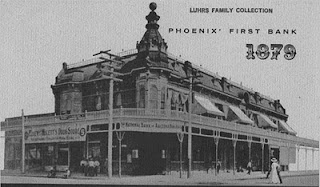
Original building 1887-1910 located on SE corner of Center (Now Central) & Washington.
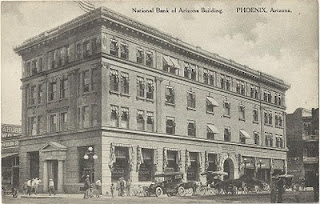
After acquiring the entire building in 1910, the bank chose to demolish it and build this modern, 4 story building (shown here in 1914)
Pre-1926 bank bag
Territorial Issues
Series 1882 - Brown Back
10-10-10-20 # 1 - 5105
10's = 15315
20's = 5105
-------------
Total = 20,415
Early "Vertical Charter" from pre 1890
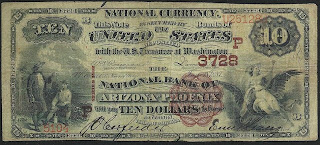

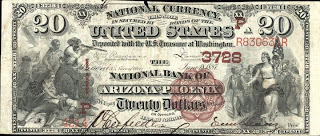
Series 1902 - Red Seal
10-10-10-20 # 1 - 1000
10's = 3000
20's = 1000
-------------
Total = 4,000
From the Smithsonian Proof Sheet, Dated June 5, 1907
Series 1902 - Date Back (1 known)
10-10-10-20 # 1 - 5300
1902 Date Back $10 (from the proof sheet) - Prepared 8/11/1908
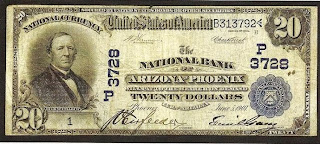
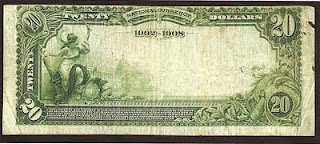
10's = 15,900
20's = 5,300
--------------
Total = 21,200
Statehood Issues
Series 1902 Date Back
10-10-10-20 # 1 - 7000
10's = 21,000
20's = 7,000
--------------
Total = 28,000
Series 1902 - Plain Back
10-10-10-20 # 7001-29700
10's = 68,100
20's = 22,700
--------------
Total = 90,800
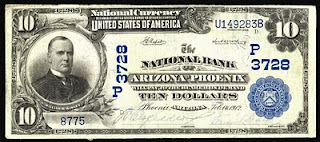
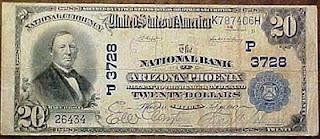
Succeeded Kales & Lewis
1926 - Title changed to "First National Bank of Arizona at PHOENIX"
The earliest charter on which notes can be reasonably obtained.

Original building 1887-1910 located on SE corner of Center (Now Central) & Washington.

After acquiring the entire building in 1910, the bank chose to demolish it and build this modern, 4 story building (shown here in 1914)
Pre-1926 bank bag
Territorial Issues
Series 1882 - Brown Back
10-10-10-20 # 1 - 5105
10's = 15315
20's = 5105
-------------
Total = 20,415
Early "Vertical Charter" from pre 1890



Series 1902 - Red Seal
10-10-10-20 # 1 - 1000
10's = 3000
20's = 1000
-------------
Total = 4,000
From the Smithsonian Proof Sheet, Dated June 5, 1907
Series 1902 - Date Back (1 known)
10-10-10-20 # 1 - 5300
1902 Date Back $10 (from the proof sheet) - Prepared 8/11/1908


10's = 15,900
20's = 5,300
--------------
Total = 21,200
Statehood Issues
Series 1902 Date Back
10-10-10-20 # 1 - 7000
10's = 21,000
20's = 7,000
--------------
Total = 28,000
Series 1902 - Plain Back
10-10-10-20 # 7001-29700
10's = 68,100
20's = 22,700
--------------
Total = 90,800


3728 First National Bank of Arizona at PHOENIX
1926
Jul 17 - Title changed from The National Bank of Arizona at PHOENIX
October, 1938
Post note issuing period:
1937 - Acquired by Transamerica Corporation along with Phoenix National Bank #4729 and other out of state banks. Arizona operations new title: "First National Bank of Arizona"
1955 - Bank headquarters moved - building remains as branch
1956 - Acquired Bank of Arizona, Prescott*
1957 - Spun off from Transamerica as part of Firstamerica Corporation
1961 - Firstamerica changes name to Western Bancorp
1963 - Building demolished - Replaced by modern branch (also now demolished)
1981 - Rebranded as "First Interstate Bank of Arizona", N.A.
1996 - Acquired by Wells Fargo
1999 - Wells Fargo acquired by Norwest, retaining Wells Fargo name.
*Acquiring this bank allowed "First National Bank of Arizona" to adopt "Since 1877" (Remembering the billboards)

This unused stock certificate from after the title change.
As seen in a now-deleted web article, The bank had plenty of original-titled currency sheets remaining at the time of its title change, and so elected to keep issuing them until 1929, when it ordered large-sized notes with the new title. As this was only about 4 months before the nationwide changeover to small-size, they did not circulate for very long, and accordingly are scarce, with only 5 known, all of which are tens. Small size, on the other hand, are very common in type 1, far less so in type 2.
A technical error exists on all large-size notes I've seen on this title. The plate date should read February 14, 1912, not June 4, 1907. Whoever designed the modified plate from the first title failed to realize the plate date should have reflected the date of Arizona's admission to The Union.
Series 1902 - Plain Back
10-10-10-20 # 1 - 5298
$10's = 15,894
$20's = 5298
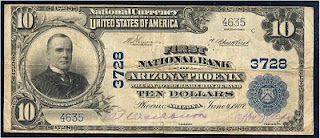
Series 1929, Type 1
$10 x 6 #1 - 8780 = 52,680
$20 x 6 #1 - 2576 = 15,456
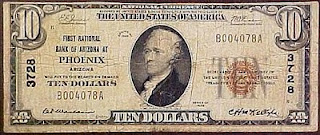

Series 1929, Type 2
$10 #1 - 12687 = 12,687
$20 #1 - 3052 = 3,052

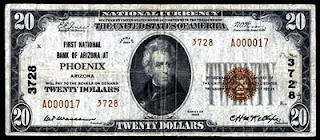
Total Large = 21,192
Total Small = 84,055
Total Issue = 105,247
Total Outstanding July 1935 = $300,000
Large Outstanding July 1935 = $7,675
Early 1960's (foreground)
Jul 17 - Title changed from The National Bank of Arizona at PHOENIX
October, 1938
Post note issuing period:
1937 - Acquired by Transamerica Corporation along with Phoenix National Bank #4729 and other out of state banks. Arizona operations new title: "First National Bank of Arizona"
1955 - Bank headquarters moved - building remains as branch
1956 - Acquired Bank of Arizona, Prescott*
1957 - Spun off from Transamerica as part of Firstamerica Corporation
1961 - Firstamerica changes name to Western Bancorp
1963 - Building demolished - Replaced by modern branch (also now demolished)
1981 - Rebranded as "First Interstate Bank of Arizona", N.A.
1996 - Acquired by Wells Fargo
1999 - Wells Fargo acquired by Norwest, retaining Wells Fargo name.
*Acquiring this bank allowed "First National Bank of Arizona" to adopt "Since 1877" (Remembering the billboards)

This unused stock certificate from after the title change.
As seen in a now-deleted web article, The bank had plenty of original-titled currency sheets remaining at the time of its title change, and so elected to keep issuing them until 1929, when it ordered large-sized notes with the new title. As this was only about 4 months before the nationwide changeover to small-size, they did not circulate for very long, and accordingly are scarce, with only 5 known, all of which are tens. Small size, on the other hand, are very common in type 1, far less so in type 2.
A technical error exists on all large-size notes I've seen on this title. The plate date should read February 14, 1912, not June 4, 1907. Whoever designed the modified plate from the first title failed to realize the plate date should have reflected the date of Arizona's admission to The Union.
Series 1902 - Plain Back
10-10-10-20 # 1 - 5298
$10's = 15,894
$20's = 5298

Series 1929, Type 1
$10 x 6 #1 - 8780 = 52,680
$20 x 6 #1 - 2576 = 15,456


Series 1929, Type 2
$10 #1 - 12687 = 12,687
$20 #1 - 3052 = 3,052


Total Large = 21,192
Total Small = 84,055
Total Issue = 105,247
Total Outstanding July 1935 = $300,000
Large Outstanding July 1935 = $7,675
Early 1960's (foreground)
4287 The Consolidated N.B. of TUCSON
1890 - Chartered, succeeding the Consolidated Bank of Tucson
1928 - Absorbed The Arizona National Bank of Tucson August 4th
1934 - Acquired by Valley Bank & Trust, Phoenix
1935 - Valley Bank & Trust -> Valley National Bank of Phoenix (#14324)
Coastal Banker (1917)
While territorials are rare, the supply of plain backs and small-size notes is the most plentiful in the state, with the exception of type 2 $5's and $10's. A hoard of uncirculated (or nearly so) type 2 $20's make them the preferred note for state sets.
Looking north on Stone @ Congress
Lobby at 1929 opening
Territorial Issues
Series 1882 - Brown Back
10-10-10-20 # 1 - 2400
50-100 # 1 - 240
$10 & $20 Brownbacks were not issued until after December 1903
Per Huntoon, the bank's $50 & $100 Brownbacks were all redeemed.
10's = 7,200
20's = 2,400
50's = 240
100's = 240
Series 1882, Dated Back
10-10-10-20 # 1 - 569
10's = 1,707
20's = 569
Series 1902 - Dated Back
10-10-10-20 # 1 - 1000
50-100 # 1 - 740
Last seen in an auction in the 1980's, this is one of but two $50's from Arizona Territory (No $50's or $100's issued with state designation)
$100's are represented by only proof sheets, as none are known from territorial days, and none were issued during statehood.
10's = 3000
20's = 1000
50's = 740
100s = 740
Total Issue = 17,836 = $345,450 (Territory)
Statehood Issues
Series 1902 - Dated Back
10-10-10-20 # 1 - 2400
10's = 7200
20's = 2400
---------------
= 9600
Series 1902 - Plain Back
5-5-5-5 # 1 - 7470
10-10-10-20 # 2400 - 26,473
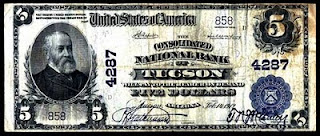

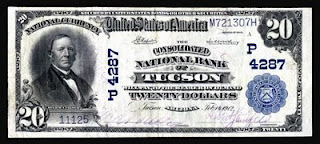
5's = 29,880
10's = 72,219
20's = 24,073
-----------------
Total = 126,172
Series 1929 - Type 1
6 x $5 # 1 - 15,412 = 92,472
6 x 10 # 1 - 7,838 = 47,028
6 x 20 # 1 - 2,826 = 15,756
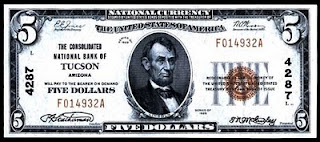

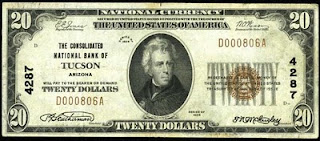
Series 1929 - Type 2
$5's # 1 - 12,388 = 12,388
10's # 1 - 5,859 = 5,859
20's # 1 - 2,099 = 2,099

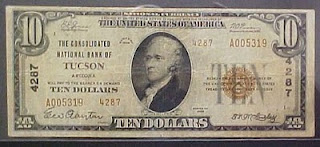
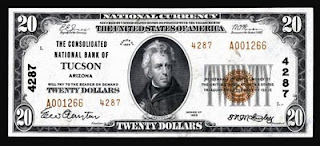
State Large = 135,772 = $1,473,050
Grand Total = 153,608 = $1,818,500 (Territory & State)
State Small = 175,602 = $1,410,270
Grand Total = 175,602 = $1,410,270 (Territory & State)
State Total = 311,374 = $2,883,320
Grand Total = 329,210 = $3,228,770 (Territory & State)
1928 - Absorbed The Arizona National Bank of Tucson August 4th
1934 - Acquired by Valley Bank & Trust, Phoenix
1935 - Valley Bank & Trust -> Valley National Bank of Phoenix (#14324)
Coastal Banker (1917)
While territorials are rare, the supply of plain backs and small-size notes is the most plentiful in the state, with the exception of type 2 $5's and $10's. A hoard of uncirculated (or nearly so) type 2 $20's make them the preferred note for state sets.
Looking north on Stone @ Congress
Lobby at 1929 opening
Territorial Issues
Series 1882 - Brown Back
10-10-10-20 # 1 - 2400
50-100 # 1 - 240
$10 & $20 Brownbacks were not issued until after December 1903
Per Huntoon, the bank's $50 & $100 Brownbacks were all redeemed.
10's = 7,200
20's = 2,400
50's = 240
100's = 240
Series 1882, Dated Back
10-10-10-20 # 1 - 569
10's = 1,707
20's = 569
Series 1902 - Dated Back
10-10-10-20 # 1 - 1000
50-100 # 1 - 740
Last seen in an auction in the 1980's, this is one of but two $50's from Arizona Territory (No $50's or $100's issued with state designation)
$100's are represented by only proof sheets, as none are known from territorial days, and none were issued during statehood.
10's = 3000
20's = 1000
50's = 740
100s = 740
Total Issue = 17,836 = $345,450 (Territory)
Statehood Issues
Series 1902 - Dated Back
10-10-10-20 # 1 - 2400
10's = 7200
20's = 2400
---------------
= 9600
Series 1902 - Plain Back
5-5-5-5 # 1 - 7470
10-10-10-20 # 2400 - 26,473



5's = 29,880
10's = 72,219
20's = 24,073
-----------------
Total = 126,172
Series 1929 - Type 1
6 x $5 # 1 - 15,412 = 92,472
6 x 10 # 1 - 7,838 = 47,028
6 x 20 # 1 - 2,826 = 15,756



Series 1929 - Type 2
$5's # 1 - 12,388 = 12,388
10's # 1 - 5,859 = 5,859
20's # 1 - 2,099 = 2,099



State Large = 135,772 = $1,473,050
Grand Total = 153,608 = $1,818,500 (Territory & State)
State Small = 175,602 = $1,410,270
Grand Total = 175,602 = $1,410,270 (Territory & State)
State Total = 311,374 = $2,883,320
Grand Total = 329,210 = $3,228,770 (Territory & State)
Subscribe to:
Posts (Atom)
